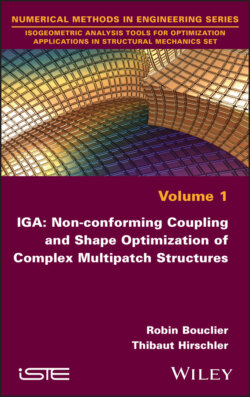Читать книгу IGA - Robin Bouclier - Страница 25
1.3.1. Returning to the original motivations behind IGA
ОглавлениеAs previously mentioned, IGA was originally introduced by Hughes et al. (2005) with a principal motivation: to reunify the worlds of CAD and CAE, which, in past decades have evolved independently (although they are closely related during engineering design and certification). Engineering design involves, on one side, the designer who generates geometric models through CAD files, and on the other side, the stress analyst who builds the inputs according to a numerical code (that calls upon FEM most of the time). The problem is that the translation of the CAD file into the FEM inputs is not straightforward in practice: an important analysis preparation step is necessary, as illustrated in Figure 1.13(a).
Note that the issue to move from design and analysis does not only concern the mesh generation, but also the efficient creation of appropriate, analysis-suitable geometries (Cottrell et al. 2009). In fact, the designer endeavors to represent, as faithfully as possible, a conceptual geometry. It means that the generated CAD model usually presents many details, for example holes, fillets and numerous sub-parts, such as bearings. Highly detailed CAD models are rarely exploitable for the simulation since it usually contains details that may be viewed as irrelevant by the analyst. As a result, in addition to the mesh generation step, a lot of time is spent generating analysis-suitable geometries, where the initial CAD model is defeatured. For sophisticated engineering systems, things can turn out to be very tricky. Different simulations such as, for example, structural mechanics, fluid dynamics, heat transfer and many others are performed. Each type of analysis has its own particular method, and thus different models are required for each of them. Figure 1.14 illustrates this point: for sophisticated engineering systems, for example, here an airplane, different visions of the same product may exist depending on the physical field. It follows that appropriate simulation-specific geometries are needed. Still looking at the example of Figure 1.14, the aerodynamicist may focus on the outer geometry of the aircraft, whereas the stress analyst is mainly concerned by the internal structure. Therefore, there is not a unique CAD model of the airplane. A lot of geometric models are required, depending on the simulation to be performed.
Figure 1.13. The original motivation of IGA is to improve engineering design and certification by integrating Design and Analysis into a single model: henceforth, designers and engineers can collaborate more intimately. For a color version of this figure, see www.iste.co.uk/bouclier/IGA.zip
Figure 1.14. Engineering systems: each engineer has their own vision and requirements for the same product (adapted from artwork by C.W. Miller)
According to Cottrell et al. (2009), the translation to analysis-suitable geometries, in addition to the meshing and the input setting for simulation codes, take de facto over 80% of the overall analysis time. It is thus clear that a stronger dialog between CAD and CAE would be of significant benefit. The engineer should be aware of what the designer does during the whole design and certification process, and vice versa. IGA brings this issue back to the table and has fostered fruitful discussions regarding a better CAD-CAE integration. As explained in Figure 1.13(b), the goal of IGA can be seen as an attempt to ease the collaboration between the designers and the engineers by integrating efficient geometric modeling possibilities and accurate simulation capabilities into a single model. As of now, it is nevertheless important to state that the dream process of Figure 1.13(b) is still not truly possible in practice, even with IGA. Indeed, we will see in section 1.4 that the prerequisites for geometric modeling and numerical simulations are too different today to envisage a direct link between design and analysis without any additional effort from the two communities. Things are starting to move forward thanks to the arrival of IGA in some commercial FE packages (see, for example, Hartmann et al. (2011, 2016); Duval et al. (2015); Lai et al. (2017) for implementations in LS-Dyna, Abaqus and Radioss, respectively). But, now more than ever, both disciplines need to work together in order to handle this common goal and define the future of engineering design. Contributions, from an analytical point of view, are present in this book, to help bridge the remaining gap between design and analysis in the context of IGA.
